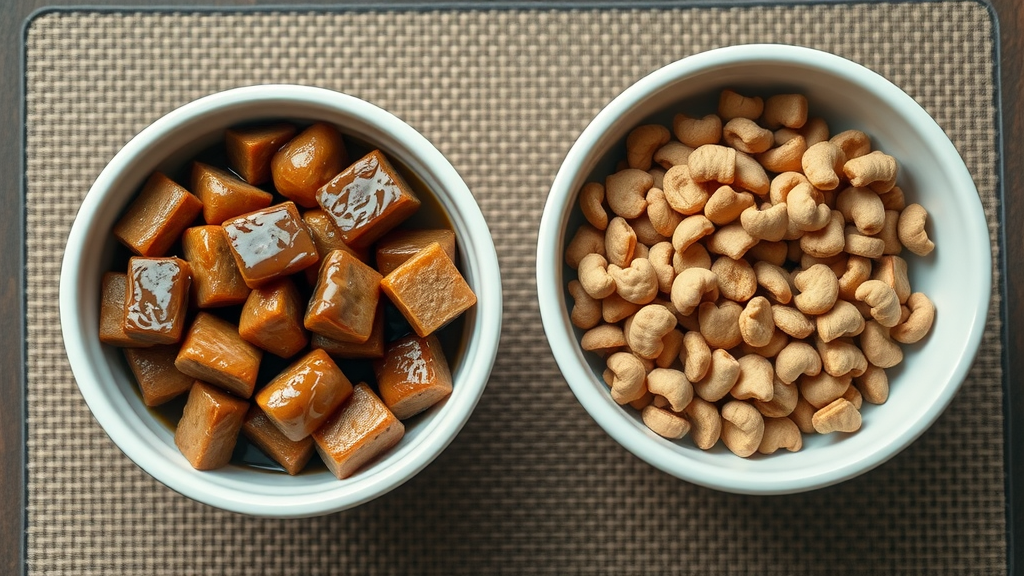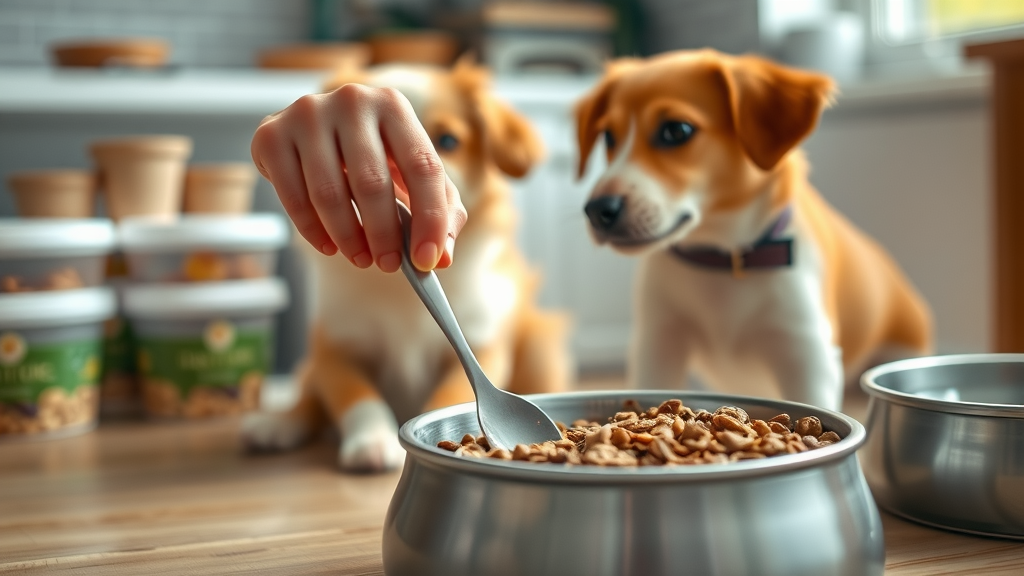Can the type of food you choose truly change your dog's health, happiness, and energy? As a devoted dog owner, you want the very best for your four-legged family member. But with shelves overflowing with both wet and dry dog food, picking the right option can feel overwhelming. Is there a clear winner for nutrition, convenience, cost, or taste? Or should you consider blending both? Dive into the science, opinions, and real-world advice on wet vs dry dog food to make the smartest decision for your pet’s unique needs.

Curious Whether Wet vs Dry Dog Food Truly Makes a Difference?
Choosing between wet and dry dog food isn’t just about personal preference or convenience—it’s a decision that can shape your dog’s health, behavior, and overall well-being. Many pet parents wrestle with questions about taste, nutrition, and the effect of each type on issues like hydration or dental health . With expert opinions often divided, understanding the actual impact of different dog foods is crucial. For instance, while dry dog food is often praised for shelf life and dental benefits, wet dog food is sometimes recommended for pets with health issues or picky eaters. Practical examples abound: a high-energy puppy might need different fuel than a senior dog with dental problems, making your choice of dog food more than just a matter of taste—it's about supporting your furry friend’s unique lifestyle and health goals.
- Discover why choosing between wet and dry dog food matters more than you may think.
- Uncover the health, taste, and nutrition factors that can impact your furry friend's daily life.
How Wet vs Dry Dog Food Affects Your Dog’s Nutrition
Macronutrient Profiles of Wet and Dry Dog Food
When analyzing the differences between wet vs dry dog food , one of the most important considerations is the variance in macronutrient content. Typically, dry food ( dry dog food or kibble) contains higher levels of carbohydrates and caloric density per serving, as moisture is minimized during processing. On the other hand, wet dog food, often referred to as canned dog food , boasts a high moisture content—sometimes up to 80%—which impacts both the volume you serve and the way your dog digests nutrients. Wet food formulas frequently feature richer protein and fat sources, making them appealing to dogs who need palatability or have trouble chewing. Yet, the higher caloric density of dry dog food means you typically need to feed smaller portions to meet your dog’s required number of calories, helping support weight maintenance with less bulk.
It’s important to choose products labeled as “ complete and balanced ,” ensuring all essential amino acids, vitamins, and minerals are provided, regardless of whether you select wet or dry diets. When comparing, always look beyond the packaging—analyzing ingredient lists and guaranteed analysis can reveal surprising differences between brands and formulas. For athletic or highly active breeds, performance formulas in either wet or dry dog foods may provide optimal macronutrient ratios to support endurance and muscle recovery. Conversely, overweight or senior dogs might benefit from specific wet dog food or dry food blends tailored for calorie control or joint support.

Ingredient Differences Between Wet Food and Dry Food
Beyond nutrients, the ingredients used in wet and dry dog food can vary greatly, influencing everything from taste and texture to digestibility and allergen risk. Wet foods typically feature less processed meats, gravies, and broths—offering enticing aromas for picky eaters and more moisture to aid hydration. Ingredients such as fresh meat, poultry, fish, and even organ meats are more common in canned dog food, whereas dry dog foods usually depend on rendered meals (like chicken meal or lamb meal), grains, and plant-based protein supplements to create crunchy kibble shapes and prolong shelf life.
Preservatives also differ significantly. Dry dog food must withstand months on the shelf, so it relies on antioxidants, vitamin E, and other agents to keep it fresh. Conversely, wet food uses hermetic sealing and cooking during canning to lock out bacteria, reducing the need for chemical preservatives. Additives, colors, and flavor boosters are more prevalent in lower-quality dry foods , but even high-end kibble or canned food can include subtle differences tailored for specific health needs—like omega-3 fatty acids for skin and coat or glucosamine for joint health. Understanding these ingredient distinctions enables the informed pet parent to tailor their dog’s bowl to both taste and health requirements.
Comparing the Benefits of Wet Dog Food vs Dry Dog Food
Benefits of Wet Dog Food: Hydration and Palatability
One of the standout benefits of wet dog food is its high moisture content , which directly supports your pet’s hydration—especially for dogs who don’t drink enough water. The soft, juicy texture and savory aroma can tempt even the most particular or senior pets to finish their meal, providing a nutritional safety net for convalescing, older, or picky dogs. Additionally, the high protein and fat content of some wet foods can provide valuable calories for underweight or highly active dogs who might need an energy boost.
Wet dog food can also be easier to chew and digest, making it popular for young puppies with small teeth or aging dogs with dental issues. The smooth consistency means it’s gentler on sensitive mouths and can help stimulate appetite when loss of smell or taste from illness is an issue. Ultimately, the palatability and hydration support of wet dog food can play a pivotal role in improving quality of life for many pets.
"Wet dog food can offer more moisture content, which is essential for dogs who don't drink enough water."

Advantages of Dry Dog Food: Convenience and Dental Health
Dry dog food , often known as kibble, stands out for its exceptional convenience and storage benefits. Pet parents appreciate the long shelf life, ease of storage, and minimal mess—making it a practical choice for busy lifestyles. The crunchy texture of dry food supports dental health by helping reduce plaque buildup and tartar as dogs chew, acting almost like a toothbrush to naturally clean teeth during regular feeding. This can be particularly important for breeds prone to dental problems or for pet parents who want to simplify their dog’s oral care routine.
Another major advantage is cost-effectiveness—measuring and portioning dry dog food is simple, and bags often deliver more meals for your money compared to wet food. For dogs prone to overeating, the lower caloric density per volume of some dry diets can also help prevent weight gain. Plus, dry kibble is easy to use for training, interactive feeders, or slow-feeding bowls, giving you more flexibility in how you feed your dog throughout the day.
Are There Downsides to Wet or Dry Dog Food?
Disadvantages of Wet Dog Food
Despite its hydration and palatability perks, wet dog food comes with several notable drawbacks. Once opened, canned dog food needs refrigeration and can spoil within hours if left out, increasing waste and requiring close attention to serving sizes. The soft, sticky texture may also cling to teeth and gums, potentially contributing to dental health issues if your dog’s teeth aren’t brushed regularly. For pet parents managing a tight budget, the cost of wet food—especially quality brands—adds up quickly, making it an expensive daily staple for large dogs or multi-pet households.
Some wet foods may lack the fiber content found in certain dry foods, which can play a role in digestive health and stool quality. Furthermore, not all wet dog foods are formulated equally; low-quality brands may contain unnecessary fillers, byproducts, or artificial flavors that don’t provide the same nutritional benefits as premium dry kibble. Overfeeding is another risk, as the appealing taste and aroma can tempt some dogs to beg for seconds, potentially leading to weight gain.
Drawbacks of Dry Dog Food
While dry dog food is highly convenient and shelf-stable, it is not without downsides. The reduced moisture content means dogs must drink sufficient water alongside their meals to avoid dehydration—especially important for active pets or those in warm climates. Some dogs, especially picky eaters or seniors with sensitive mouths, may find the crunchiness of dry dog food difficult or unappealing, leading to decreased food intake or nutritional imbalances if left unchecked. Additionally, some commercial kibbles can be higher in carbohydrates and use low-quality fillers or artificial preservatives, potentially exacerbating allergies or digestive issues for sensitive pets.
Dental health claims about kibble rely on regular, thorough chewing—dogs who gulp or swallow pieces whole don’t experience the same cleaning benefits, and tartar may still build up. Lastly, dry dog food may be less palatable for some dogs due to its lack of aroma and variety compared to wet foods, leading to decreased enthusiasm for meals and possible underfeeding if not carefully managed.
| Aspect | Wet Dog Food | Dry Dog Food |
|---|---|---|
| Nutritional Content | Higher moisture, protein-rich; may have more fats | Higher carbs, calorie-dense, less moisture |
| Price | More expensive per serving | More economical, bulk pricing available |
| Storage | Requires refrigeration after opening | Shelf-stable; store in airtight container |
| Shelf Life | Short once opened | Long; can last months unopened |
| Convenience | Messier; single-serve cans/trays available | Easy to measure, store, travel with |
| Health Impact | Aids hydration, easy to chew, appealing taste | Supports dental health, may reduce tartar |
Wet and Dry Dog Food: Veterinary and Pet Parent Perspectives
Veterinarian Insights into Choosing Dog Food
When it comes to selecting wet or dry dog food , veterinarians urge pet parents to focus on their dog’s individual needs rather than simply picking a trend. Age, activity level, existing health conditions, and breed-specific tendencies should guide the choice. For example, growing puppies and working dogs may thrive on higher-calorie wet or dry foods packed with protein, while older pets with dental challenges benefit more from soft, moist meals. Consulting a veterinarian helps identify potential allergies or medical considerations—such as kidney disease or dental problems—that may make one type preferable over the other.
"Your dog’s age, health, and lifestyle should guide your decision between wet and dry food," notes Dr. Rachel Bernstein, DVM.
Vets stress that any food—wet, dry, or a combination—must be “ complete and balanced ” per the Association of American Feed Control Officials (AAFCO) guidelines to ensure long-term health. Regular checkups and open dialogue with your vet are crucial for monitoring your dog’s response to new foods and adjusting your approach as your dog’s needs evolve with age or lifestyle changes.
Common Pet Parent Experiences
Real-world experiences shared by pet parents reveal a spectrum of preferences and results when feeding wet and dry dog food . Many owners report that mixing wet and dry food (“topper feeding”) makes mealtime more enticing for picky eaters or dogs with reduced appetites, easing transitions and adding nutritional variety. Some notice improvements in coat shine, stool quality, or increased energy following a diet change. However, others highlight practical obstacles—like the greater expense and shorter shelf life of wet food or the initial reluctance of some pets to switch from one type to another.
Ultimately, each family’s routine, budget, and their dog’s unique preferences play a significant role. Keeping a close eye on your dog’s weight, digestion, and enthusiasm for meals provides helpful feedback on whether their current dog food choice is truly a good fit.
- Real pet parents share their stories about switching between wet food, dry food, and mixed feeding.

Feeding Wet, Dry, or Canned Dog Food: Making the Right Choice
Factors to Consider: Breed, Age, Dental Health, and Allergies
Choosing the ideal dog food—whether wet, dry, or a combination—means evaluating multiple unique factors about your dog. Size and breed can dictate the optimal kibble size or wet food portions, while age affects everything from energy requirements to protein type. Dogs with sensitive teeth or recovering from dental procedures might benefit most from soft, easily digestible wet food. Conversely, breeds prone to tartar buildup could gain more from the crunch of dry food for routine dental maintenance. Allergies and sensitivities also play a role; identifying intolerances to ingredients like wheat, corn, or certain proteins may necessitate switching between formulas until a suitable match is found.
Beyond physical health, lifestyle considerations—such as time available for food prep, storage capacity, and budget—directly shape your ideal solution. Whether you’re a pet parent managing a multi-dog household, a frequent traveler, or simply pining for maximum convenience, your daily realities influence the practicality of each type of dog food . Consulting your veterinarian about medical history and following feeding guidelines will further fine-tune your selection.
- Checklist for choosing between wet and dry dog food, including health requirements and lifestyle.
Should You Mix Wet and Dry Dog Food?
Mixing wet and dry dog food is a popular approach, allowing pet owners to balance the best features of each. Combining both can enhance palatability, boost moisture intake (especially handy for dogs on a dry diet), and add variety to prevent picky eating. For dogs needing higher caloric intake, adding a little wet food topper provides extra flavor and nutrients without drastically increasing meal sizes. Conversely, mixing in kibble helps control costs and maintains the dental health benefits of dry food.
However, attention to total portion size and calorie count is crucial to prevent unintentional overfeeding. Gradually introducing mixed feeding helps minimize digestive upset and allows you to monitor how your dog responds to new foods. Consult your veterinarian to ensure your tailored meal plan is balanced and meets all your dog’s nutritional needs.
Is It More Cost-Effective to Feed Wet or Dry Dog Food?
Price Comparison: Canned Dog Food vs Dry Dog Food
Cost stands as a primary concern for many dog owners when choosing between canned dog food and dry food . While wet dog food typically delivers superior taste and hydration benefits, it carries a much higher price per serving due to packaging, shipping, and portion sizes. Dry dog food, on the other hand, is available in larger bags often at wholesale or discount prices, making it the economic favorite—especially for multi-pet households or larger breeds. Mixed feeding strategies fall in the middle, offering some nutritional diversity while maintaining budget control.
Certain boutique wet foods or protein-rich dry kibbles can be premium-priced, so always compare cost per meal, not just the price on the bag or can. Discounts, nutrition quality, and your dog’s specific dietary needs can all swing the value equation in either direction. Long-term expenses should also account for potential health benefits or issues, such as dental care for dry food eaters or hydration-related vet visits for those on dry-only diets.
| Feeding Type | Average Cost Per Serving | Estimated Monthly Cost (Medium Dog, 30 lbs) |
|---|---|---|
| Wet Dog Food | $2 - $3 | $100 - $140 |
| Dry Dog Food | $0.90 - $1.50 | $35 - $55 |
| Mixed Feeding | $1.40 - $2.30 | $65 - $115 |
People Also Ask: Wet vs Dry Dog Food
Is it better to feed dogs wet or dry food?
- The answer depends on your dog’s health, preference, age, and any recommendations from your vet. Many dogs thrive on both, but some conditions favor one type over the other.
What are the disadvantages of wet dog food?
- Wet dog food is more expensive, spoils faster after opening, and can stick to teeth, potentially impacting dental health.
Can dogs eat wet food every day?
- Yes, many dogs can eat wet food daily, provided the nutrition is balanced and portion sizes are appropriate for their age, size, and activity level.
Is it okay to feed a dog only dry food?
- Yes, as long as the dry dog food is labeled complete and balanced, it can form the entirety of a dog’s diet. Ensure your dog is adequately hydrated.
Practical Tips for Introducing Wet or Dry Dog Food
How to Transition Between Dry and Wet Dog Food Safely
Switching your dog’s food should always be handled gradually to minimize digestive upset. Begin by mixing a small amount of the new food type with the current food—starting with roughly 75% old food and 25% new. Over the course of 7-10 days, slowly adjust the ratio until your dog is eating an entirely new mix. Monitor for signs of discomfort, such as loose stools or vomiting, and pause or slow the transition if problems arise. Always provide fresh water, follow recommended feeding guidelines, and consult with your veterinarian should questions or concerns emerge during the switch.
- Step-by-step guidance for a smooth dog food changeover: reducing digestive upset, monitoring your pet’s reaction.

Signs Your Dog’s Food is the Right Fit
You’ll know you’ve chosen the right dog food when your pup displays consistent energy levels, a shiny coat, healthy skin, and a healthy weight. Regular, firm stools, visible enthusiasm at mealtime, and absence of allergic reactions or digestive upsets are other excellent indicators. If your dog becomes a picky eater, gains or loses weight unexpectedly, or develops skin or coat problems, it might be time to revisit your food selection or consult your vet for tailored advice.
Pet parents should continually observe their furry friend’s behavior and overall health, adjusting as their dog ages or experiences lifestyle changes.
Frequently Asked Questions about Wet vs Dry Dog Food
- Dental Health: Does dry food really clean teeth? Somewhat, but brushing is still best for dental health.
- Allergies: Can certain kibble or canned foods trigger allergies? Yes. Switch formulas or seek hypoallergenic options if problems persist.
- Fussy Eating: What if my dog is a picky eater? Mixing wet and dry, or rotating flavors can help.
- Storage: How do I store unused food? Refrigerate wet; keep dry in a sealed container.
- Combining Foods: Is it safe to combine canned and kibble? Yes, with correct portions and vet approval.
- Feeding Frequency: How often should I feed my dog? Most adult dogs do best with two meals per day.
Key Considerations Before Deciding Between Wet and Dry Dog Food
- Check with your vet, monitor your dog’s health, and choose a feeding style that fits your pet’s needs.

Ready to Choose Wet vs Dry Dog Food? Set Your Dog Up for Success
- Experiment with different dog food types, observe your dog’s health, and consult your veterinarian for tailored nutritional advice. Make an informed choice in fueling your companion’s health and happiness.
Conclusion: Assess your pet’s lifestyle and health, try both food types as needed, and collaborate with your veterinarian to ensure nutritional success.
When deciding between wet and dry dog food, it’s essential to consider factors such as your dog’s health, preferences, and lifestyle. For a comprehensive understanding, the article “Dry vs. Wet Dog Food, or Both?” on PetMD provides an in-depth comparison of both types, discussing their benefits and potential drawbacks. ( petmd.com ) Additionally, Purina’s article “Wet vs. Dry Dog Food: What’s Best for Dogs” offers insights into how each food type affects nutrition, dental health, and convenience. ( purina.com ) Exploring these resources will equip you with the knowledge to make an informed decision tailored to your dog’s unique needs.
 Add Row
Add Row  Add
Add 








Write A Comment